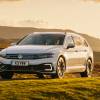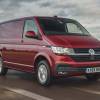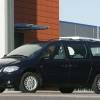
Complete peace of mind for less
• £50 off a mobile car service†
• We get to most breakdowns in 60 mins or less
• Our patrols fix 4/5 on the spot
* At least 10% of new customers paid this or less since 12/08. †Applies to new Extra or Complete cover. Restrictions apply, check mobile mechanic eligibility & availability here. Ends 18/11, 4pm.

Volkswagen's most topical EV is the ID. Buzz People Carrier. Jonathan Crouch drives it.
Ten Second Review
The Volkswagen ID. Buzz trendily redefines what a large family MPV can be for the new EV era. Practicality is sacrificed on the altar of fashion but hey, this EV's fun but sensible, enviro-conscious but desirable. Which makes it very unusual indeed.
Background
With the ID. Buzz, one of motoring's most iconic models, the Volkswagen Bus, has finally been reinvented. The old Type 2 model it references, in production for a quarter of a century between 1950 and 1975, is still (after the Beetle) Volkswagen's second most recognisable vehicle, variously known as the 'Camper', the 'Bulli' and the 'Hippie van' but most commonly called the 'Microbus' or more usually, just the 'Bus'. The Wolfsburg maker's been promising to recreate it since the turn of the century, first with the 'Microbus concept' of 2001, then with the 'Bulli concept' of 2011, followed by the 'BUDD-e' of 2015 and most recently the 'ID. Buzz Cargo concept' in 2018.
That's quite a gestation period, but Volkswagen's been waiting for the technology to properly recreate this vehicle for a new electrified era and needed to launch its ID. series of electric hatch models first. This ID. Buzz becomes the fourth of them, a trend-setting People Carrier that's quickly become the Internet's favourite MPV. Sold both in passenger-carrying MPV and commercial 'ID. Buzz Cargo' van forms, it's built in Hanover alongside the brand's more conventional Multivan MPV. And it's like no other model of its kind.
Driving Experience
Silent running was never a feature of the old chugging rear-engined, rear-driven Volkswagen Type 2 but of course the all-electric ID. Buzz is very different. Its powerplant, a 204PS electric motor borrowed from the ID.4, is still rear-mounted though, here developing far more grunt than drivers of the old 'Bus could ever dream about, 310Nm of it. Though if you regularly exercise all of that, you won't of course get anywhere near the 77kWh battery's quoted EV driving range of 258 miles. As usual with an electric vehicle, torque feels instant and drive comes via the usual EV fixed-ratio single-speed auto gearbox to the rear wheels (though twin motor 4WD versions are planned in future). And 62mph from rest occupies 10.2s, en route to the very modest top speed of 90mph - at last, something Type 2 owners of the Sixties will properly recognise.
You sit commandingly, using a drive selector stalk on the right of the steering wheel. On the move, surprisingly, at least to some degree, the Buzz can deliver both comfort and a little sportiness. It feels like the premium product its price point demands, and in fact is one of the best-riding electric cars we've driven. Body roll is kept tight through corners, and the level of refinement is excellent, not just for the MPV class, but any class. We're not so impressed by the lack of brake energy recuperation options: there just an extra 'B' gear selector function to heighten energy harvesting off-throttle. But in every other way, the ID. Buzz is a revelation to drive.
There's a tight 11-metres turning circle (a metre better than the Multivan), which along with the glassy cabin should make the Buzz feel very manoevreable in town. All the usual VW drive assist features are available - Matrix headlights, 'car2x' swarm informational technology and the 'Travel Assist' semi-autonomous drive system.
Design and Build
If you like retro looks, you'll get the Buzz, which references its 1960's Type 2 Volkswagen Bus predecessor with an uncluttered look, distinctive 2-tone paintwork and super-short overhangs front and rear. The 3-bar motif on the D-pillar is supposed to recall the cooling louvres for the old Type 2's rear-mounted air-cooled engine. And under the skin, the Buzz sits on the rear-propelled MEB platform used by smaller ID. series hatchbacks. Size-wise, at 4,712mm in length, it's a touch shorter than the brand's Multivan MPV. That's in the ID.Buzz model's initial short wheelbase five-seat form. Eventually, there'll be a 7-seat option and also a long wheelbase version with three seating rows.
Up front, you sit quite high with a wide view through the vast windscreen. The high-mounted minimalist dashboard is unique and houses a 5.3-inch digital instrument display and a centre touchscreen that's either of 10 or 12-inches, depending on chosen spec. The auto gear lever is on the steering column. A compartment called the 'Buzz Box' hinges down from the base of the dash, revealing a couple of cup holders, a bottle opener and an ice scraper. Rear seat space is generous but you don't get individual chairs. The bench you do get slides and reclines, but can't be removed. Out back, there's a 1,121-litre boot up to window level, extendable to 2,205-litres with the 60:40-split backrest folded. Optional on the base model is a raised 'Multi-flex' floor. The 'Cargo' van version can swallow a (rather modest) 3.9 cubic metres.
Market and Model
The model is available with two main trim levels: 'Life' and 'Style'. The entry-level Life starts at just under £59,000 and offers LED headlights, a heated windscreen, the Buzz box removable storage, Discover Pro navigation and infotainment with a 10-inch colour touchscreen, plus wireless charging. 'Style' trim (priced from around £64,000) adds larger 20-inch wheels, the 'IQ. Light' LED matrix headlights and tailgate surround lighting. Inside with 'Style'-spec, there's much nicer 'Miwi' part-vegan-leather upholstery, a 'silver birch'-trimmed dash panel, a 30-colour adaptive ambient lighting system and a 'Multi-flex' cargo area loading base with a detachable net.
All ID. Buzz variants feature a digital cockpit and are available with the brand's iconic two-tone paint option. With up to nine USB-C 45-watt ports, 'Hello ID.' voice control and online functionality via We Connect and We Connect Plus, the ID. Buzz is well connected.
The ID. Buzz Cargo van version is quite a lot cheaper, with ex-VAT prices starting from just over £43,000, though that could reduce if the government decides that this model is eligible for a Plug-in grant. There are two trim levels - 'Commerce' and 'Commerce Plus'. Eventually, expect an ID.Buzz California camper version too.
This is theoretically one of Volkswagen's Commercial Vehicles, which means that all the brand's van dealers will stock it, but not all of the company's car dealerships will. If you want to try an ID.Buzz, it's best to go to the Volkswagen website, find this model, click on the 'test drive' option, then enter your post code, at which point the page should give you the Volkswagen van or car stockist with Buzz availability nearest to you.
Cost of Ownership
As we told you in our 'Driving' section, the EV range is 258 miles from the 77kWh battery (gross capacity 82kWh). The ID. Buzz Cargo has an EV range of 256 miles. You'll want to know about charging, which with either variant takes place using a Type 2 connector and works via an on-board charger with a maximum power of 11kW. This replenishes the battery from empty to full in about twelve and a quarter hours from a normal 7.4kW garage wall box. You can reduce that to about eight and a quarter hours if you happen to have a three-phase grid connection. But if you simply plug-in using a regular domestic plug, you're looking at charging taking 39 hours and 30 minutes.
If you're out and about and find a rapid charger, you can use that thanks to the provided CCS connection. The maximum rapid charge power is rated at 175kW, but in an average charging session, the charging power will be at about 115kW, which replenishes the battery from 10 to 80% in about half an hour. Such a rapid charge will give you about 140 miles of driving range.
Finally, there's the warranty. Volkswagens of any kind are limited to three years of cover, but with a Volkswagen Commercial Vehicle (which is what the ID. Buzz is classed as), the mileage limit in this period is raised from 60,000 to 100,000 miles. There's also three years of pan-European Roadside Assistance also included with no mileage restriction. The paintwork warranty lasts for three years and the ID. Buzz is protected by a 12-year anti-corrosion body warranty.
Summary
Was it worth the wait? Fashionista families will think so because there's really nothing else quite like an ID. Buzz. Overnight, it's made the idea of an MPV potentially fashionable again, just like its Type 2 predecessor did half a century ago. Unfortunately, it's not affordable to ordinary folk in the way that model was, but the children of the hippies who rumbled about in the Type 2 back in the '60s may not mind that. And trendy businesses wanting to make a green-minded statement will flock to the Cargo version.
In reality of course, the Buzz shares virtually nothing but a few styling cues with the design that inspired it. Here in reality is an ID.4 hatch with an airier body and an MEV platform stretched as far as it can go. Not far enough, inevitably perhaps, to make it as practical for families as a Volkswagen Transporter Shuttle or even a Multivan. But the Buzz will raise a smile wherever it goes. And for that, you can't help liking it.







